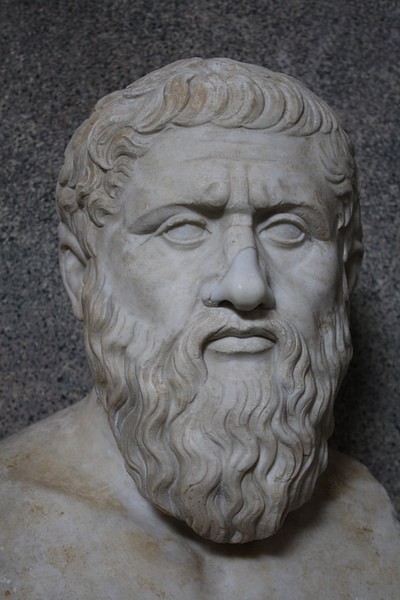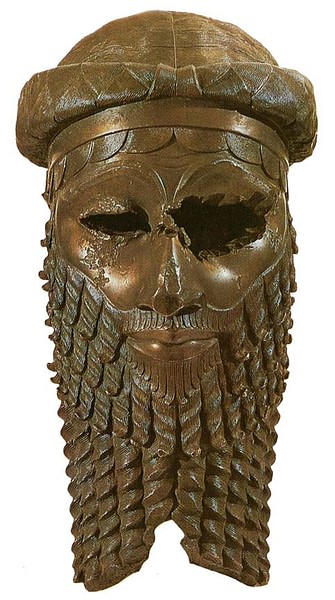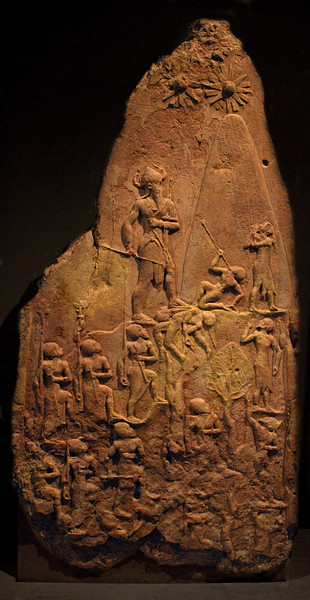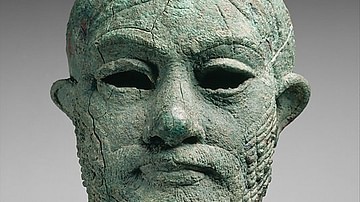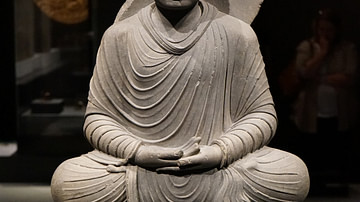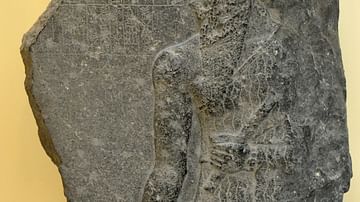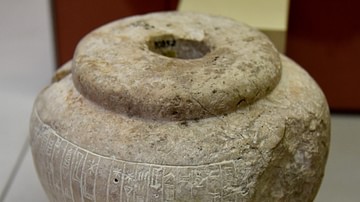Originality in literary compositions in the ancient world did not carry the same weight and value as it does today. In recent centuries, authors have been applauded for the creation of original works and have been derided for plagiarism or for passing off a work as a true account - especially a first-person account - when it is not.
This same paradigm did not hold true for the ancient world. In the modern day, an author creates an original work and hopes it will catch the interest of the majority of the reading public and become a best-seller; in the ancient world an author could simply assume the identity of an already famous person, write an account using their name and point of view, and present it to the reading public as an authoritative, first-person account.
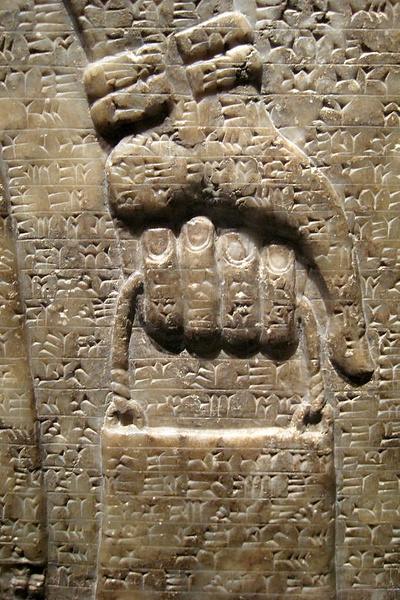
In Mesopotamia, such works were very popular - as they would later become in other cultures - and are known today as the literary genre "Naru literature". The stories created by the writers in this genre replaced whatever historical truth there may have been and, in time, became the truth. This seems to have been the effect of much of the Naru literature. The myth, in time, became the reality. Regarding this, the scholar Gerdien Jonker writes:
It should be made clear that the ancient writers were not aiming to deceive with their literary creations. The literature inspired by the naru formed an excellent medium with which, by departing from traditional forms, a new social "image" of the past could be created. (95)
Naru Literature & the Bible
Whether such works were actually accepted as true accounts by the people of the time is a matter of some debate, but if one considers the narratives concerning the life of Jesus Christ - both the gospel stories that make up the first four books of the New Testament and those that were excluded - it seems quite likely they were.
None of the extant manuscripts detailing the life and teachings of Jesus were written by those who experienced the events first-hand; they were written after the evangelical missions of Saint Paul had already established the divine nature of Jesus and the purpose of his mission (sometime between c. 50-90 CE). This is not to say there is no truth to those narratives, only quite likely not historical truth. The gospel narratives fit completely with the tradition of Naru literature.
Like the Mesopotamian works, they were not written by the eyewitnesses to the events - whose names have come to be accepted as the authors - and they make use of known historical persons and events to lend credence to the narrative. Their final purpose was not as "history" but as stories concerning the life of a holy man who had made an impression on people.
Matthew, Mark, Luke, and John were not the names of the authors of the four canonical gospels; those names were purposefully chosen for the weight they would carry with an ancient audience who might recognize them as associated with Jesus. While this may trouble modern-day readers, it would not have been a matter of great consequence to an ancient audience, who seems to have accepted the works as composed by men who had actually known Jesus and heard his teachings.
By the time the gospel stories were written, the history of Jesus' ministry, in various forms, was already known. The purpose of the manuscripts that are known as the gospels, as the Book of Luke states, is to give authoritative accounts of Jesus' life and teaching but the fact that Luke begins the narrative by noting there are many different versions of the story (which his narrative will correct) strongly suggests a central character whose life lent itself to many different interpretations:
Many have undertaken to draw up an account of the things that have been fulfilled among us, just as they were handed down to us by those who from the first were eyewitnesses and servants of the word. With this in mind, since I myself have carefully investigated everything from the beginning, I too decided to write an orderly account for you, most excellent Theophilus, so that you may know the certainty of the things you have been taught. (Luke 1:1-4)
The Book of Luke is the only gospel in which the narrator does not present himself (or, as some have claimed, herself) as an eyewitness to the events described. The purpose stated is to provide "an orderly account" of Jesus' life so that the reader can discriminate between this account and others which may have been circulating at the time. The author of Luke makes clear from the first line in the book that it is not an eyewitness account, but this is the exception to the rule.
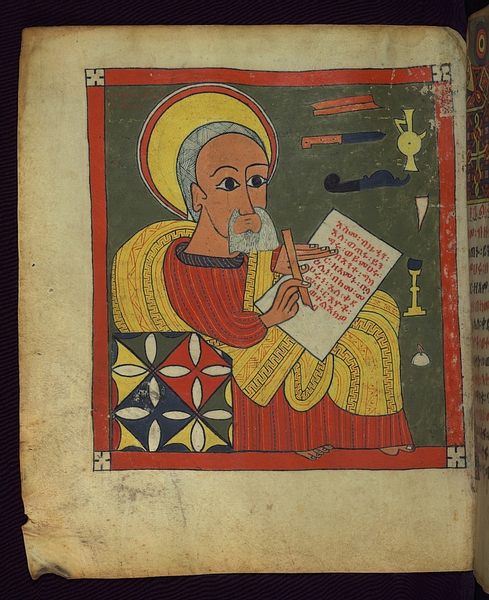
In the Old Testament, the Song of Solomon (also known as The Song of Songs) is another example of the Naru literature model at work, in that the book begins in chapter 1:1 with the line, "The Song of songs, which is Solomon's". The work has been dated to between the 6th and 3rd centuries BCE, while Solomon lived c. 970-931 BCE. He certainly could have written an earlier version of The Song of Solomon, but it is generally believed it was created by someone later making use of his famous name. This same paradigm applies to biblical books such as Ecclesiastes, Proverbs, and Psalms, which are regularly attributed to either Solomon or his father King David but were most likely written, or compiled, by later authors.
The Naru Paradigm in Plato
This same pattern of the Naru literature is also seen in the works of Plato, in which he presents his teacher Socrates in situations that would appear to a reader or hearer to be narrated by an actual witness to the events. Although Plato places himself in the jury in the dialogue of Apology, scholars have challenged whether what Socrates said that day accords with Plato's version of the events since Xenophon (l. 430 - c. 354 BCE) gives a different version of the trial and, in Plato's dialogue of the Phaedo, which recounts the last hours of Socrates' life, the author states he was not present but delivers an account under the name of a fellow-student, Phaedo.
The historical Phaedo is said to have repudiated the dialogue as fiction, but that did not stop the dialogue of the Phaedo (or Plato's Book of the Soul, as it was known) from being widely read and appreciated. Originality in composition may have had its personal rewards for the writer but, in publishing, a recognizable name was most important. Phaedo had been a slave who Socrates arranged to have freed so he could study philosophy and, after his teacher's death, began his own school and was as well known in Athens as Plato.
Although Plato needed no assistance in finding an audience for his work, a dialogue featuring the popular Phaedo as the main character would have had great appeal. Whether Plato or Phaedo were actually present in Socrates' cell during his last hours no longer matters; the dialogue in which Phaedo tells the story of that day has now become the historical truth.
The Purposes of Naru Literature
This practice of writing supposedly true stories which one had not actually experienced oneself, like many practices, concepts, and inventions, originated in Mesopotamia in the genre of Naru literature. According to the scholar O.R. Gurney:
A naru was an engraved stele, on which a king would record the events of his reign; the characteristic features of such an inscription are a formal self-introduction of the writer by his name and titles, a narrative in the first person, and an epilogue usually consisting of curses upon any person who might in the future deface the monument and blessings upon those who should honour it. The so-called "naru literature" consists of a small group of apocryphal naru-inscriptions, composed probably in the early second millennium B.C., but in the name of famous kings of a bygone age. A well-known example is The Legend of Sargon of Akkad. In these works the form of the naru is retained, but the matter is legendary or even fictitious. (93)
Scholars continually debate whether such stories should rightly be called "Naru literature" or "fictitious autobiography" but, whichever term one uses, the works purposefully represent themselves as first-person accounts of an event of significance from which an audience is supposed to learn some important information, whether the "truth" of historical events, a religious moral, or simply some lesson which was thought useful to those hearing the tales. The term "Naru literature" comes from "naru", which is explained by scholar Gerdien Jonker:
The word naru is used as a name for various objects, originally boundary stones, memorial stones and monuments. Two sorts of inscribed objects received the designation naru at the dawn of the second millennium: tablets accompanying presents and tablets used for building inscriptions. At the end of the third millennium the naru chiefly played a part in religious transactions; at the beginning of the second millennium it was to become not only actually but also symbolically the bearer of memory. (90)
As the bearers of actual memory, Naru literature carried enormous significance for those who heard the tales, and this was especially true of those stories concerning the great kings of the Akkadian Empire, Sargon the Great (r. 2334-2279 BCE) and his grandson Naram-Sin (r. 2261-2224 BCE). These two, more than any other figures from ancient Mesopotamia, figured most prominently in the later Naru literature of the region. The Legend of Sargon of Akkad mentioned earlier by Gurney is presented as Sargon's autobiography - and was accepted as such by an ancient audience - but most probably is a legendary account first given out in an effort to win the hearts and minds of the lower-class Sumerian populace Sargon wanted support from in conquering Sumer.
He presents himself as having been born the illegitimate son of a priestess, set adrift on the Euphrates River soon after his birth, rescued by a gardener and then, through the help of the goddess Inanna, rising to become king of Akkad. At the time Sargon came to power in 2334 BCE, Sumer was a region which had only recently been united under the king of Umma (and later of Uruk), Lugalzagesi and, even then, it was not a cohesive union. Prior to Lugalzagesi's conquest, Sumerian cities were frequently at war with each other vying for resources such as water and land rights. Further complicating the situation was the discrepancy between the rich and the poor. The historian Susan Wise Bauer writes on this, commenting:
Sargon's relatively speedy conquest of the entire Mesopotamian plain is startling, given the inability of Sumerian kings to control any area much larger than two or three cities [but the Sumerians] were suffering from an increased gap between elite leadership and poor laborers. [The rich] used their combined religious and secular power to claim as much as three-quarters of the land in any given city for themselves. Sargon's relatively easy conquest of the area (not to mention his constant carping on his own non-aristocratic background) may reveal a successful appeal to the downtrodden members of Sumerian society to come over to his side. (99)
By presenting himself as a "man of the people" he was able to garner support for his cause and took Sumer with relative ease. Once the south of Mesopotamia was under his control, he went on to create the first multi-national empire in history. That his reign was not always popular, once he was securely in power, is attested to by the number of revolts his inscriptions say he was forced to deal with. Early on, however, his appeal would have been great to people who were tired of the wealthy living as they pleased at the expense of the working lower class.
The later Persian monarch Darius I (the Great, r. 522-486 BCE) is thought to have drawn on Sargon's example in his Behistun Inscription (commissioned c. 520 BCE) in which he gives an account of his rise to power. A number of modern-day scholars claim that Darius I usurped the throne of the Achaemenid Empire but, according to his inscription, his advancement was due to divine grace conferred by the supreme god Ahura Mazda and, further, he was simply removing a lawless usurper who had no claim to rule. Whether Darius I was telling the truth is of no consequence because his reign was so effective and impressive it legitimized itself.
Famous Examples of Naru Literature
Other pieces of Naru literature from the 2nd millennium BCE, such as those concerning Naram-Sin, made clear the role of the gods in people's lives and how one should behave in dealing with divinity. The work known as The Great Revolt, a kind of historical fiction, makes use of the historical rebellions against Naram-Sin's early rule but then embellish on the facts in order to impress upon an audience the military brilliance of Naram-Sin and the ungrateful nature of the city of Kish, which organized the rebellion against him. In the Legend of Cutha (also known as the Cutha Legend and the Kutha Legend), also from the 2nd millennium BCE, the importance of listening to, and obeying, the will of the gods is the focus.
In this story, Naram-Sin's kingdom is invaded by an army of seemingly superhuman creatures (associated, by their description, though not by name, with the Gutians). They destroy everything in their path and appear to be invincible. Naram-Sin sends one of his soldiers to prick one of the creatures with a knife and see if it bleeds. When the soldier returns and reports that the creature bled, Naram-Sin knows that, if they bleed, they can be killed. He then consults the gods to discover their will in this situation and whether he should attack the invaders.
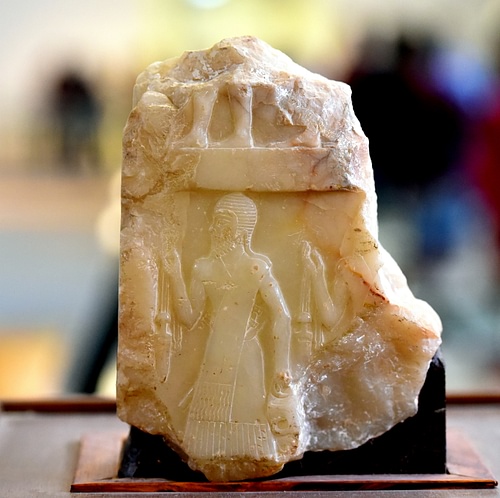
The oracle tells him not to attack, nor does he receive any word from the gods in his dreams. Even so, he ignores the god's wishes saying:
What lion ever practiced divination? What wolf inquired of an interpreter of dreams? Let me go like a bandit, following the counsel of my own heart. Let me disregard the counsel of the god; let me take responsibility for myself. (lines 80-83)
He sends forth 120,000 troops against the invaders and "not one from among them returned alive" (line 85). Still following the counsel of his own heart, he sends out 90,000 troops and none of them return either. Believing the third time will turn out differently, he sends out another 60,700 troops but they also are killed in battle. At this point the king realizes he has not chosen well and cries out:
What have I left behind as the legacy of my reign? I am a king who has not looked after his land, and a shepherd who has not looked after his people. How can I keep proceeding? How can I save the country? (lines 90-93)
Naram-Sin then humbles himself before the gods at the New Year's Festival and seeks their will. When he next encounters the invaders, in the form of twelve of their soldiers he has captured, he vows he will not proceed with punishment until he has heard the will of the gods. The gods tell him not to hurt the prisoners and, further, to do nothing to repel the invaders because the great god Enlil has plans to destroy them himself; this was why they told him not to attack his enemies in the first place.
Enlil, he is told, will take care of the invading forces and "raise them up for evil. They await the furious heart of Enlil" (lines 131-132). Naram-Sin accepts the will of the gods and delivers the prisoners to them at the temple. The work ends with the admonition that whosoever shall read it in the future should heed the message and hearken to the will of the gods instead of relying on the counsel of their own heart and doing what they think best.
As in The Great Revolt, the message would have meaning for nobility and common people alike. Even though the work ends with an address to a ruler, it would have been well received by anyone hearing it in the same way that readings from the Bible are received in the modern day. The message is the same as that found in the biblical Book of Proverbs 3:5: "Trust in the Lord with all thine heart; and lean not unto thine own understanding." Naram-Sin, at the beginning of the story so arrogant as to consider himself wiser and more capable than his gods, is humbled at the end and ostensibly has written this inscription as an admonition to others.
Another work featuring Naram-Sin that seems to have been very popular was The Curse of Agade, which explained why the gods destroyed the city of Akkad. Although this work is not technically Naru literature (as it is not told in the first person and does not follow the standard progression of inscriptions), it certainly is derived from the genre, and some scholars (such as Gerdien Jonker) do consider it part of the Naru genre, in that some of those tales are also written in the third person.
The city of Akkad was the seat of the Akkadian Empire (2334-2083 BCE) which fell to an invasion of the Gutians in 2083 BCE. It later became the basis of stories and legends and would continue to inspire the same for millennia. The Curse of Agade explains why Akkad was destroyed by the Gutians and, further, how it is futile to challenge the will of the gods because only they know what their plans are and human beings cannot be privy to such knowledge.
In this tale, the god Enlil takes his grace away from Akkad and Naram-Sin petitions the heavens for seven years for the reason why. Finally frustrated with the silence of the gods, he takes matters into his own hands. Those acquainted with the Bible will recognize in Naram-Sin's next move the antithesis of Job who refused to curse God and die and continued to believe that his redeemer lived. Naram-Sin, grown tired of receiving no answer to his prayers or redress for his suffering, mobilizes his army and marches on Enlil's sacred city of Nippur where he destroys the Ekur, Enlil's temple. He "sets his spades against its roots, his axes against the foundations until the temple, like a dead soldier, falls prostrate" (Leick, The Invention of the City, 106). He then destroys even the ruins.
This attack, of course, provokes the wrath not only of Enlil but of the other gods who send the Gutians - "a people who know no inhibition, with human instincts but canine intelligence and with monkey features" (Leick, 106) - to invade Akkad and lay it waste. There is widespread famine after the invasion of the Gutians, the dead remain rotting in the streets and houses, and the city is in ruin and so, according to the tale, ends the once-glorious city - and empire - of Akkad because of the king's arrogance and lack of faith.
The Curse of Agade is told in the third person but still from the point of view of someone who witnessed the events it describes. In the actual historical record, there is no evidence that Naram-Sin ever sacked Nippur or destroyed the temple of Enlil. The scholar Gwendolyn Leick, among others, has suggested that The Curse of Agade is a work written later, most likely sometime before 2047 BCE, to express "an ideological concern for the right relationship between the gods and the absolute monarch" (Leick, 107), whose author chose Akkad and Naram-Sin as subjects because, by that time, they were legendary.
According to the historical evidence, Naram-Sin honored the gods and was very pious. What the historical king may have been like, and what he did, was of no consequence to the author of The Curse of Agade; what mattered was the moral of the story, and historical truths that did not fit that story were of no importance.
Conclusion
Again, as mentioned above, to a modern reader such a practice may be interpreted as dishonest but, to an ancient hearer of the tale, the story's message was important, not the "facts" contained therein. Plato discusses this in his work Republic, Book II, when he is addressing the concept of the True Lie (also known as the Lie in the Soul). In discussing various kinds of untruths, he has the character of Socrates say:
Whereas the lie in words is in certain cases useful and not hateful; in dealing with enemies – that would be an instance; or again, when those whom we call our friends in a fit of madness or illusion are going to do some harm, then it is useful and is a sort of medicine or preventative; also in the tales of mythology, of which we were just now speaking – because we do not know the truth about ancient times, we make falsehood as much like truth as we can, and so turn it to account. (378-382d)
Mythology has always explained to human beings how the world works, where people came from, why they are here, and mythology has always been accepted by those hearing the tales, either in whole or in part, literally or figuratively, as conveying truth. Whether in the ancient or the modern world, human beings need to feel secure in their lives and believe there is some purpose in rising every day and facing the world. Whether one relies on philosophy or religion, on Plato or the Bible, or on one's own experience and the progress of scientific inquiry, one is still seeking some kind of assurance that the world, and one's life, has meaning and purpose.
Naru literature in ancient Mesopotamia provided that assurance by giving readers an understanding of the world governed by gods who had an intimate concern with human choice and action. In a work such as The Legend of Sargon of Akkad, that lesson might be that one could rise from unfortunate beginnings, with the help of the gods, to become king, while in The Legend of Cutha the message could be summed up in the lines from the biblical Book of Ecclesiastes 5:2: " Be not rash with thy mouth, and let not thine heart be hasty to utter anything before God: for God is in heaven, and thou upon earth: therefore let thy words be few."
Naru literature made use of past historical time periods to deliver messages of meaning to an audience seeking such meaning; whether the details of those stories were actually true was irrelevant as long as the message resonated in the hearts of those who heard the stories told. In this capacity, Naru literature played a vital role in society by transmitting central cultural values via dramatic, and memorable, stories. As noted, this same paradigm would be followed by later writers in other cultures in order to impress an important cultural, philosophical, or religious value on an audience.
